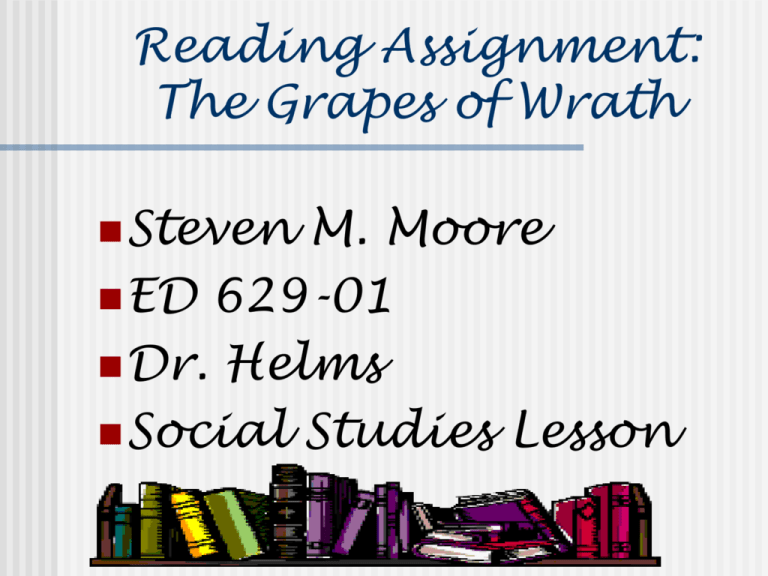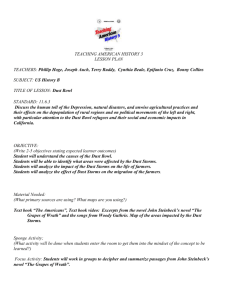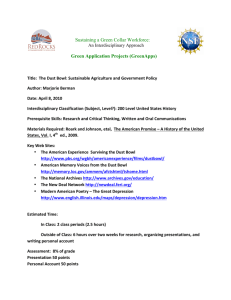Steven Moore - Wright State University
advertisement

Reading Assignment: The Grapes of Wrath Steven M. Moore ED 629-01 Dr. Helms Social Studies Lesson Unit/Grade Level/Lesson Unit: The Dustbowl Region of the 1930s in the United States Grade Level: Sixth or Seventh Grade Lesson: Reading of the Grapes of Wrath with background information on the Author and the setting. Objectives (Taken from p.40 of the To analyze different perspectives on the Dustbowl using a variety of sources Organize historical information in text format and draw own conclusions ODE SS Standards) Present a position and support it with evidence and citation of sources Work effectively in a group Web Sites for Information on John Steinbeck John Steinbeck Page http://ocean.otr.usm.edu/~ wsimkins/steinb.html John Steinbeck (1902-1968) http://www.kirjasto.sci.fi/joh nstei.htm Center for Steinbeck Studies http://www2.sjsu.edu /steinbeck/ Web Sites for Information on the Dustbowl 1930’s Dustbowl http://www.ptsi.net/user /museum/dustbowl.html National Drought Mitigation Center http://www.drought.unl. edu/index.htm Student Poster Activity Create a poster similar to that used in the Grapes of Wrath to recruit new workers The students should work in groups to maximize the use of 1930’s propaganda Materials Needed Posterboard Markers/Color Pencil to outline Willingness to work with your team Needs to have a picture, neat letters, & proper grammar Student Writing Activity Students in a group of four Each student in a group writes a fictional story based in the Dustbowl region The papers must be inter-related to each other; i.e.: the students move together but show the story from their point of view. Materials Needed Spend 15 minutes in your group brainstorming the fictional story Each student writes the brainstormed events from their own point of view Students shall compare stories to see how they inter-connect John Steinbeck Life in California John Steinbeck was born on February 27, 1902 to John Ernst and Olive Steinbeck. He grew up at this house in Salina, California. The Early Years 1919-1925- Attended classes at Stanford University. Originally an English major, he pursued his interests rather than following a particular course of study. He dropped out for several months to work at many different jobs. 1925- Steinbeck left Stanford for good without graduating. Life in New York November 1925- He left California to pursue a writing career in New York. He worked at a variety of jobs including construction work on Madison Square Garden and reporting for the New York American. 1926 -A lack of acceptance of his writing in New York led Steinbeck to return to California. Home to California While back home in California, John Steinbeck started writing a number of novels about his childhood home of Salina. •1929 Cup of Gold-first novel published •1932 The Pastures of Heaven •1933 To A God Unknown The California Novels •1935 Tortilla Flat - his first popular success •1936 In Dubious Battle •1937 Of Mice and Men and The Red Pony •1938 The Long Valley •1939 The Grapes of Wrath - Steinbeck’s greatest critical success •1940 Films of Of Mice and Men and Grapes of Wrath were released. The Return to New York After separating from his first wife, Steinbeck moved to New York in 1941, publishing several more books leading up to his death. •1942 The Moon is Down •1945 Cannery Row •1947 The Wayward Bus and The Pearl •1950 Burning Bright •1952 East of Eden •1954 Sweet Thursday •1961 The Winter of Our Discontent Non-Fiction Writing 1938 Their Blood is Strong- about migrant labor problems 1941 Sea of Cortez- written with Edward Ricketts 1942 Bombs Away- World War II accounts 1943 War Correspondent for New York Herald Tribune 1948 A Russian Journal- story of his 1947 Russian trip 1952 The Log from the Sea of Cortez 1958 Once There was a War- 1943 war dispatches 1962 Travels With Charley- journal of 1960 tour of the US Awards and Honors 1938 -The New York Drama Critics Award for the play version of Of Mice and Men 1940- The National Book Award and The Pulitzer Prize for The Grapes of Wrath 1962 - Awarded the Nobel Prize for Literature 1964 - Presented with the United States Medal of Freedom by President Lyndon Johnson The Nobel Prize for Literature “The ancient commission of the writer has not changed. He is charged with exposing our many grievous faults and failures, with dredging up to the light our dark and dangerous dreams for the purpose of improvement.” Nobel Prize Acceptance Speech 1962 The Dust Bowl What was the Dust Bowl? The Dust Bowl of the 1930s lasted about ten years affecting the southern Plain States. Oklahoma, Kansas, Texas, and New Mexico were some of the most hardest hit and devastated lands. What Caused the Dust Bowl? The Dust Bowl was caused by poor farming practices and years of consistent drought. Poor Farming Practices Plains grasslands had been deeply plowed and planted with wheat. During the years when there was plenty of rainfall, the lands produced good crops. But as the droughts of the early 1930s deepened, the farmers kept plowing and planting making the land very infertile for new crops. Clouded Terror! The Plains winds whipped across the fields raising large and thick clouds of dust to the sky. The sky could darken for days. Even the most well sealed homes could have a thick layer of dust on the furniture. The dust could be compared to heavy drifting snow. Woody Guthrie Woody Guthrie was a popular folk singer in the 1930s through the 1940s. He wrote songs that told stories about the heartland of America. Guthrie was born July 14, 1912, in Okema, Oklahoma. He lived through the Dust Bowl, writing songs to entertain the Dust Bowl refugees he traveled with on the road. In the 1940s, Guthrie recorded a series of songs he called the Dust Bowl Ballads. Here is an example of one of his ballads, called Dust Bowl Blues Dust Bowl Blues By: Woody Guthrie I just blowed in, and I got them dust bowl blues, (repeat) I just blowed in, and I’ll blow back out again. I guess you’ve heard about ev’ry kind of blues, (repeat) But when the dust gets high, you can’t even see the sky. I’ve seen the dust so black that I couldn’t see a thing, (r.) And the wind so cold, boy, it nearly cut you water off. I seen the wind so high that it blowed my fences down,(r.) Buried my tractor 6 feet underground. Well, it turned my farm into a pile of sand, (r.) I had to hit that road with a bottle in my hand. I spent ten years in that old dust bowl, (r.) When you get that dust pneumony, boy, it’s time to go. I had a gal, and she was young and sweet, (r.) But a dust storm buried her 16 feet. (Continuing before song completes will end it) Dust Bowl Blues (cont.) She was a good gal, long, tall, and stout, (r.) I had to get a steam shovel just to dig my darlin’ out. These dust bowl blues are the dustiest ones I know, These dust bowl blues are the dustiest ones I know, Buried head over heels in the black old dust, I had to pack up and go. An’ I just blowed in, an’ I’ll soon blow out again. From: http://blueslyrics.tripod.com Dust Bowl Refugees Like the Joads, many people tried to flee the Plain States. Many coming from Kansas, Oklahoma, Texas, New Mexico, Nevada, and Arkansas moving west to California. There were many homeless families who went to look for jobs.





